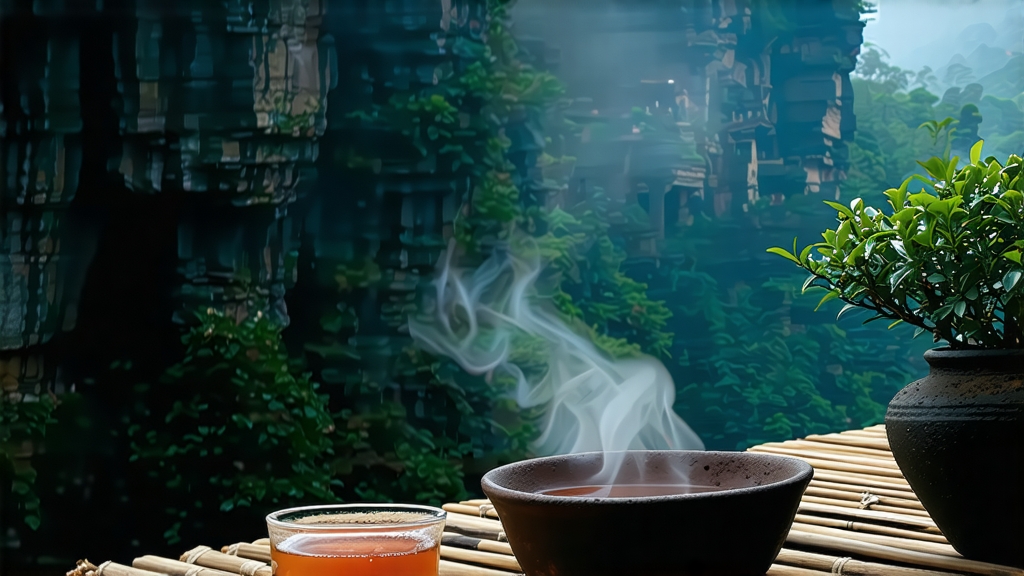
If green tea is the fresh-faced scholar of Chinese tea and pu-erh the venerable sage, then Da Hong Pao—Big Red Robe—must be the warrior-poet who strides between them, armor clinking with the scent of smoke and flowers. Originating in the vertiginous Wuyi Mountains of northern Fujian, this oolong commands legend, geology and craftsmanship in every twisted, jet-black leaf. International drinkers often meet it first through airport gift-shop tins, yet the real Da Hong Pao is a revelation of minerality and lingering sweetness that can silence a room faster than a temple bell.
Legend sets the stage. During the Ming dynasty, a passing scholar was cured of illness by tea plucked from six bushes clinging to a narrow rock ledge above the Nine-Dragon Gorge. Grateful, he wrapped the bushes in his own crimson imperial robe to protect them from the mountain cold—hence the name. Whether myth or marketing, the tale fixed the tea’s identity: rare, medicinal, worthy of emperors. In 2006 the Chinese government declared those six mother trees a national treasure; plucking from them ceased, and the last 20 g of their leaf now rests invisibly in the China National Museum. What circulates today are three authentic bloodlines: cuttings propagated directly from the mothers (called “purebred” or qizhong), offspring of those cuttings grown in the same micro-terroir (yanzhong), and high-quality Wuyi cultivars blended to emulate the original flavor profile (shipin). Each offers a different ticket to the same cliff-side concert.
The Wuyi range is a 550-million-year-old slab of volcanic and metamorphic rock, repeatedly faulted into a labyrinth of gorges where morning mist refracts light like frosted glass. Daytime heat reflected off the stone walls is stored overnight, creating a 10-15 °C diurnal swing that forces the tea bush to thicken its cell walls, concentrating aromatic oils and minerals. Locals speak of “rock rhyme” (yanyun)—a tactile aftertaste of wet stone, iodine and orchid that arrives minutes after you swallow. Geologists trace the sensation to quartz-rich schist that weathers into a gravelly, fast-draining soil laced with potassium and manganese. No other oolong terroir duplicates it; even neighboring valleys only 15 km away fail the blindfold test.
Crafting Da Hong Pao is a 24-hour choreography of stress and rest. Picking begins at dawn when two leaves and a bud are still curled like sleeping bats. Leaf is transported down the cliff in wicker backpacks, then sun-withered on bamboo screens for 30–45 minutes, just long enough for the edges to feel like soft leather. Indoor withering follows in rooms scented faintly of previous firings; oxidation is coaxed by repeated tossing in bamboo drums, each impact bruising the leaf edge while leaving the vein intact. A master can read oxidation by ear: the rustle must sound like silk, not cardboard. When the leaf turns jade at the vein and mahogany at the rim, firing interrupts the enzymes. Traditionally this is done in a 200 °C charcoal pit lined with local tuff; today many producers use electric ovens for consistency, but the top lots still demand three rounds of hand-charcoal roasting, each followed by a month of “sleep” so that latent moisture migrates outward. The result is a leaf that is 65 % oxidized—past the greenness of Tie Guan Yin yet short of the darkness of fully roasted Wuyi black—locking in a spectrum that spans lilac, honey, cocoa and the scent of a struck flint.
To brew Da Hong Pao well, treat it like a shy guest who reveals secrets only when the room is quiet. A 120 ml gaiwan or small Yixing teapot is ideal; pre-heat with boiling water, then fill one-third full with leaf—more than you think polite. The first infusion, 5 seconds at 100 °C, is a handshake: rinse and discard. The second, 10 seconds, releases orchid and burnt cream; by the fourth, mineral grit blooms into a texture like river stones licked by rain. Push the leaf to 45 seconds by the seventh infusion; good Da Hong Pao will yield 9–12 rounds before its bass note fades. Always sip from a white porcelain cup—colored glaze